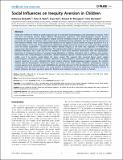| dc.contributor.author | McAuliffe, Katherine | |
| dc.contributor.author | Blake, Peter R. | |
| dc.contributor.author | Kim, Grace | |
| dc.contributor.author | Wrangham, Richard W. | |
| dc.contributor.author | Warneken, Felix | |
| dc.date.accessioned | 2014-04-04T13:57:45Z | |
| dc.date.available | 2014-04-04T13:57:45Z | |
| dc.date.issued | 2013-12 | |
| dc.date.submitted | 2013-06 | |
| dc.identifier.issn | 1932-6203 | |
| dc.identifier.uri | http://hdl.handle.net/1721.1/86015 | |
| dc.description.abstract | Adults and children are willing to sacrifice personal gain to avoid both disadvantageous and advantageous inequity. These two forms of inequity aversion follow different developmental trajectories, with disadvantageous inequity aversion emerging around 4 years and advantageous inequity aversion emerging around 8 years. Although inequity aversion is assumed to be specific to situations where resources are distributed among individuals, the role of social context has not been tested in children. Here, we investigated the influence of two aspects of social context on inequity aversion in 4- to 9-year-old children: (1) the role of the experimenter distributing rewards and (2) the presence of a peer with whom rewards could be shared. Experiment 1 showed that children rejected inequity at the same rate, regardless of whether the experimenter had control over reward allocations. This indicates that children’s decisions are based upon reward allocations between themselves and a peer and are not attempts to elicit more favorable distributions from the experimenter. Experiment 2 compared rejections of unequal reward allocations in children interacting with or without a peer partner. When faced with a disadvantageous distribution, children frequently rejected a smaller reward when a larger reward was visible, even if no partner would obtain the larger reward. This suggests that nonsocial factors partly explain disadvantageous inequity rejections. However, rejections of disadvantageous distributions were higher when the larger amount would go to a peer, indicating that social context enhances disadvantageous inequity aversion. By contrast, children rejected advantageous distributions almost exclusively in the social context. Therefore, advantageous inequity aversion appears to be genuinely social, highlighting its potential relevance for the development of fairness concerns. By comparing social and nonsocial factors, this study provides a detailed picture of the expression of inequity aversion in human ontogeny and raises questions about the function and evolution of inequity aversion in humans. | en_US |
| dc.language.iso | en_US | |
| dc.publisher | Public Library of Science | en_US |
| dc.relation.isversionof | http://dx.doi.org/10.1371/journal.pone.0080966 | en_US |
| dc.rights | Publisher with Creative Commons License | en_US |
| dc.rights.uri | http://creativecommons.org/licenses/by/4.0/ | en_US |
| dc.source | PLoS | en_US |
| dc.title | Social Influences on Inequity Aversion in Children | en_US |
| dc.type | Article | en_US |
| dc.identifier.citation | McAuliffe, Katherine, Peter R. Blake, Grace Kim, Richard W. Wrangham, and Felix Warneken. “Social Influences on Inequity Aversion in Children.” Edited by Emma Flynn. PLoS ONE 8, no. 12 (December 2, 2013): e80966. | en_US |
| dc.contributor.department | Massachusetts Institute of Technology. Program in History, Anthropology, and Science, Technology, and Society | en_US |
| dc.contributor.department | Massachusetts Institute of Technology. Program in Science, Technology and Society | en_US |
| dc.contributor.mitauthor | Kim, Grace | en_US |
| dc.relation.journal | PLoS ONE | en_US |
| dc.eprint.version | Final published version | en_US |
| dc.type.uri | http://purl.org/eprint/type/JournalArticle | en_US |
| eprint.status | http://purl.org/eprint/status/PeerReviewed | en_US |
| dspace.orderedauthors | McAuliffe, Katherine; Blake, Peter R.; Kim, Grace; Wrangham, Richard W.; Warneken, Felix | en_US |
| dc.identifier.orcid | https://orcid.org/0000-0001-8556-8874 | |
| mit.license | PUBLISHER_CC | en_US |
| mit.metadata.status | Complete | |
